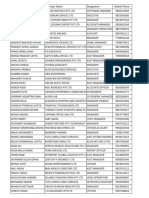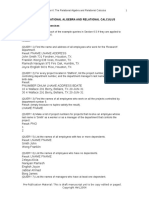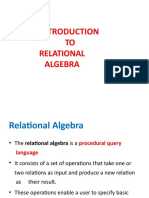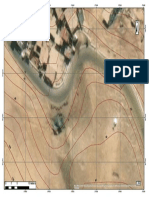0 ratings0% found this document useful (0 votes)
265 viewsNormalization Example: Project Management Report
The document describes the process of normalizing a company project report into third normal form (3NF) in four steps:
1) Create an initial un-normalized table (UNF) from the report data.
2) Transform the UNF into first normal form (1NF) by removing any repeating attributes into separate tables.
3) Transform the 1NF into second normal form (2NF) by removing non-key attributes that depend on only part of a compound key.
4) Transform the 2NF into third normal form (3NF) by removing non-key attributes that depend more on other non-key attributes than on the table key.
Uploaded by
DEE SAR DSNCopyright
© © All Rights Reserved
Available Formats
Download as PDF, TXT or read online on Scribd
0 ratings0% found this document useful (0 votes)
265 viewsNormalization Example: Project Management Report
The document describes the process of normalizing a company project report into third normal form (3NF) in four steps:
1) Create an initial un-normalized table (UNF) from the report data.
2) Transform the UNF into first normal form (1NF) by removing any repeating attributes into separate tables.
3) Transform the 1NF into second normal form (2NF) by removing non-key attributes that depend on only part of a compound key.
4) Transform the 2NF into third normal form (3NF) by removing non-key attributes that depend more on other non-key attributes than on the table key.
Uploaded by
DEE SAR DSNCopyright
© © All Rights Reserved
Available Formats
Download as PDF, TXT or read online on Scribd
You are on page 1/ 3
Normalization Example
Below is an extract from a company report, which describes projects being
worked upon by employees. This report is to be “normalized”.
Project Management Report
Project Code: PC010
Project Title: Pensions System
Project Tae Hyung Project Budget: $24,500
Manager:
Emp No Emp Name Dept No Dept Name Hourly Rate
S1001 YoonA L004 IT $22.00
S1003 Y S Ho L023 Business $20.50
S2101 K S Hyun L004 IT $21.00
Total Staff on Project: 3 Average Hourly Rate: $21.17
Step 1: Un-normalized Form (UNF)
Select the data source and convert into an un-normalized table (UNF)
The process is as follows:
Create column headings for each data item on the report (ignoring any
calculated fields).
Enter sample data into table.
Identify a key for table (and underline it).
Remove duplicate data (in this example, for the chosen key of Project
Code, the values for Project Code, Project Title, Project Manager and
Project Budget, hourly rate are duplicated if there are two or more
employees working on the same project).
UNF: Un-normalized Table
Step 2: First Normal Form (1NF)
Transform a table of un-normalized data into first normal form (1NF).
Rule: remove any repeating attributes to a new table.
The process is as follows:
Identify repeating attributes.
Remove these repeating attributes to a new table together with a copy
of the key from the UNF table.
Assign a key to the new table (and underline it). The key from the
original un-normalized table always becomes part of the key of the
new table. A compound key is created. The value for this key must be
unique for each entity occurrence.
1NF with Repeating Attributes Removed
Step 3: Second Normal Form (2NF)
Transform the data in first normal form (1NF) into second normal form
(2NF).
Rule: remove any non-key attributes that only depend on part of the
table key to a new table.
Ignore tables with (a) a simple key or (b) with no non-key attributes (these
go straight to 2NF with no conversion).
The process is as follows:
Take each non-key attribute in turn and ask the question: is this attribute
dependent on one part of the key?
If yes, remove attribute to new table with a copy of the part of the key
it is dependent upon. The key it is dependent upon becomes the key in
the new table. Underline the key in this new table.
If no, check against other part of the key and repeat above process.
If still no, i.e. not dependent on either part of key, keep attribute in
current table.
2NF: Partial Key Dependencies Removed
Step 4: Third Normal Form (3NF)
Transform the data in second normal form (2NF) into third normal form
(3NF).
Rule: remove to a new table any non-key attributes that are more
dependent on other non-key attributes than the table key.
Ignore tables with zero or only one non-key attribute (these go straight to
3NF with no conversion).
The process is as follows:
If a non-key attribute is more dependent on another non-key attribute than
the table key:
Move the dependent attribute, together with a copy of the non-key
attribute upon which it is dependent, to a new table.
Make the non-key attribute, upon which it is dependent, the key in the
new table. Underline the key in this new table.
Leave the non-key attribute, upon which it is dependent, in the original
table and mark it a foreign key (*).
3NF: Non-Key Dependencies Removed
You might also like
- KX-NS Version 8.0 Software Release Note: October 15, 2019No ratings yetKX-NS Version 8.0 Software Release Note: October 15, 201942 pages
- Experiment No.:-1: Aim:-Introduction To HTML100% (1)Experiment No.:-1: Aim:-Introduction To HTML5 pages
- Lab-Iv Unix and Shell Programming Laboratory (CSE-224: PrerequisitesNo ratings yetLab-Iv Unix and Shell Programming Laboratory (CSE-224: Prerequisites2 pages
- Normalization of Database: First Normal Form (1NF)No ratings yetNormalization of Database: First Normal Form (1NF)10 pages
- CS-462 - Compiler Construction - Final Term100% (1)CS-462 - Compiler Construction - Final Term2 pages
- Lecture 01 - Introduction To DBMS, MS AccessNo ratings yetLecture 01 - Introduction To DBMS, MS Access11 pages
- Lab Exam Question Paper - Web Programming Tech - Batch 2,3,4No ratings yetLab Exam Question Paper - Web Programming Tech - Batch 2,3,43 pages
- Solution: Entity Relationship Model Exercise +100% (1)Solution: Entity Relationship Model Exercise +6 pages
- OS SRTF Scheduling Algorithm - JavatpointNo ratings yetOS SRTF Scheduling Algorithm - Javatpoint3 pages
- Assignment No. 2 Database Management SystemNo ratings yetAssignment No. 2 Database Management System9 pages
- Lexical Analysis - Compiler Design: Token, Pattern and LexemeNo ratings yetLexical Analysis - Compiler Design: Token, Pattern and Lexeme5 pages
- Expanded Pine Valley Furniture Company Database: Background100% (1)Expanded Pine Valley Furniture Company Database: Background31 pages
- Simulation of Congestion Control Algorithm AimNo ratings yetSimulation of Congestion Control Algorithm Aim4 pages
- Clientno Cname Propertyno Paddress Rentstart Rentfinish Rent Ownerno OnameNo ratings yetClientno Cname Propertyno Paddress Rentstart Rentfinish Rent Ownerno Oname3 pages
- Chapter 6: The Relational Algebra and Relational Calculus: Answers To Selected ExercisesNo ratings yetChapter 6: The Relational Algebra and Relational Calculus: Answers To Selected Exercises4 pages
- CH 3-Interactive SQL & Advance SQL: Performance Tuning (INBUILT Functions - String & Arithmatic Functions String FunctionsNo ratings yetCH 3-Interactive SQL & Advance SQL: Performance Tuning (INBUILT Functions - String & Arithmatic Functions String Functions40 pages
- Database Management System (CSC631) : B+ TreeNo ratings yetDatabase Management System (CSC631) : B+ Tree5 pages
- Arid Agriculture University, Rawalpindi: Final Exam / Fall 2020 (Paper Duration 24 Hours) To Be Filled by TeacherNo ratings yetArid Agriculture University, Rawalpindi: Final Exam / Fall 2020 (Paper Duration 24 Hours) To Be Filled by Teacher10 pages
- Cse-Vii-Advanced Computer Architectures (10CS74) - Assignment PDFNo ratings yetCse-Vii-Advanced Computer Architectures (10CS74) - Assignment PDF6 pages
- L36-37-Converting ER Diagram To Relational SchemaNo ratings yetL36-37-Converting ER Diagram To Relational Schema36 pages
- Development of A Project by Making Use of Tools Studied AboveNo ratings yetDevelopment of A Project by Making Use of Tools Studied Above7 pages
- SYNC IEC60870-5 104 Slave Interface Usermanual Rev1.0.9No ratings yetSYNC IEC60870-5 104 Slave Interface Usermanual Rev1.0.924 pages
- Cerro Herradura Practica Curva de Nivel A3No ratings yetCerro Herradura Practica Curva de Nivel A31 page
- Setting Up Remote Desktop Services and Adding Intouch Windowviewer To Remoteapp List On An Intouch Access Anywhere Server MachineNo ratings yetSetting Up Remote Desktop Services and Adding Intouch Windowviewer To Remoteapp List On An Intouch Access Anywhere Server Machine15 pages
- Masina Taiat Iarba - Electrolux Bernard Loisirs 605350 DATASHEETNo ratings yetMasina Taiat Iarba - Electrolux Bernard Loisirs 605350 DATASHEET3 pages
- Wiggins Vr300 Non Pressurising Ultra Fast Fil Diesel Refuelling SystemsNo ratings yetWiggins Vr300 Non Pressurising Ultra Fast Fil Diesel Refuelling Systems3 pages
- Exco Approval and Motivation - Router Swap - UpdatedNo ratings yetExco Approval and Motivation - Router Swap - Updated6 pages
- Function: Maintenance & Repair at Operational LevelNo ratings yetFunction: Maintenance & Repair at Operational Level2 pages
- A Novel Healthy and Time Aware Food Recommender Syst - 2023 - Expert Systems Wit PDFNo ratings yetA Novel Healthy and Time Aware Food Recommender Syst - 2023 - Expert Systems Wit PDF22 pages
- CCP6214-Algorithm Design and Analysis ApprovedNo ratings yetCCP6214-Algorithm Design and Analysis Approved3 pages
- 2024 Barcelona Conference Program-Nov. 7No ratings yet2024 Barcelona Conference Program-Nov. 724 pages
- HCLTech IDC MarketScape Worldwide Adobe Experience Cloud Professional Services 2022No ratings yetHCLTech IDC MarketScape Worldwide Adobe Experience Cloud Professional Services 202212 pages
- Hydraulic/Hydrostatic Schematic S250 (S/N 521315300 AND ABOVE) (S/N 521411322 AND ABOVE) S300 (S/N 521512919 AND ABOVE) (S/N 521611082 AND ABOVE)No ratings yetHydraulic/Hydrostatic Schematic S250 (S/N 521315300 AND ABOVE) (S/N 521411322 AND ABOVE) S300 (S/N 521512919 AND ABOVE) (S/N 521611082 AND ABOVE)2 pages
- Special Gearbox Oil: For Vacuum Pumps and CompressorsNo ratings yetSpecial Gearbox Oil: For Vacuum Pumps and Compressors1 page

























































































